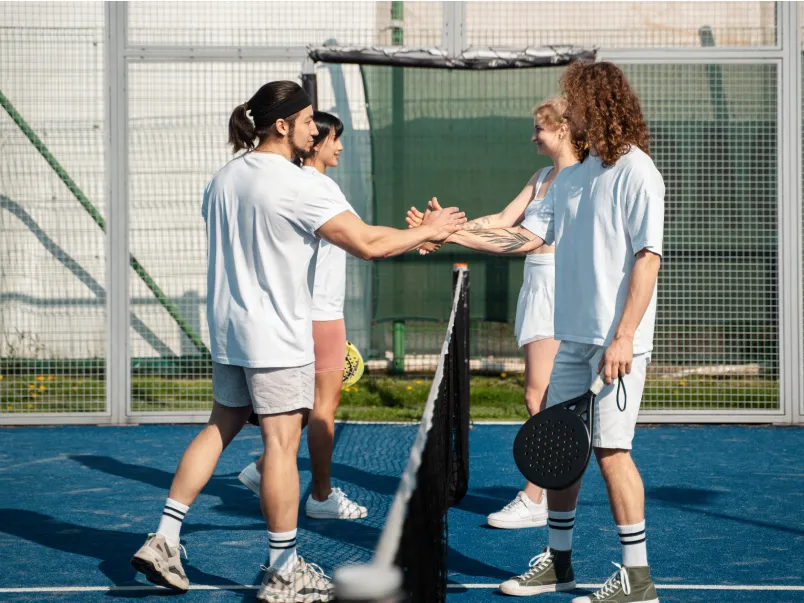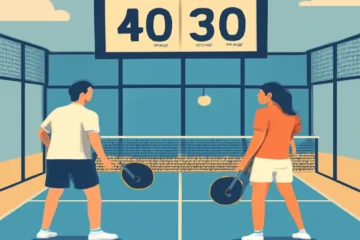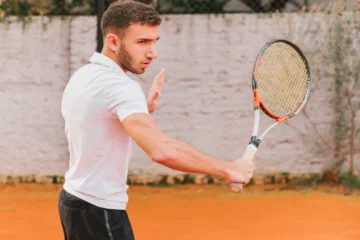Padel is taking the world by storm. This fast-paced, social sport is gaining popularity globally, and whether you’re an experienced player or just starting, there’s no better way to enjoy it than with a fun match. However, while playing padel is undoubtedly thrilling, organizing a match can seem daunting, especially if you’re trying to bring together a group of players. But don’t worry! This guide is here to help you organize your next local padel match, from gathering players to creating a memorable on-court experience. Follow these simple, manageable steps, and you’ll soon be known as the go-to organizer in your local padel community.
Phase 1: The Foundation – Gathering Your Players
The first step to organizing a successful padel match is ensuring you have the right group of players. Whether you’re gathering friends or strangers for a casual hit or organizing a competitive game, this phase sets the tone for the event. Here’s how to get started:
1.1. Determine the Format
Before you begin reaching out to potential players, it’s essential to decide what type of match you want to organize. The format will determine how many players you’ll need and what the overall vibe of the game will be.
- Singles vs. Doubles: In padel, doubles is by far the most common and social format. It allows for more players, making the game more engaging and providing a great opportunity for social interaction. However, singles can be a fun and competitive challenge if you’re looking for a more intense match.
- Casual Hit vs. Competitive Match: Are you organizing a laid-back, fun game where everyone is welcome, or are you looking to crown a winner in a more competitive setting? If your goal is to keep things light and social, keep the focus on fun and casual play. For those aiming to compete, consider setting up a tournament-style match with a defined winner.
1.2. Find Your Players
Once you’ve decided on the match format, it’s time to find the players. The ideal group size for a padel match is either 4 or 8 players. This allows for smooth rotations and keeps the game lively.
- Where to Look: Start by reaching out to local padel clubs or checking noticeboards for players. Many communities have online WhatsApp or Facebook groups where players frequently post about upcoming games. If you already have a few friends or colleagues who play, this is the perfect opportunity to invite them.
- Skill Level: Be sure to communicate the expected skill level of the game. If it’s a friendly match for beginners, make sure to mention it so players of similar levels can join. If you’re aiming for a competitive game, make sure you communicate that as well so players know what to expect.
1.3. Communicate Clearly
Communication is key when gathering players for your padel match. Once you have a potential group, send out clear information regarding the match’s date, time, format, and expected skill level. Make sure everyone knows what they’re signing up for and give them enough time to confirm their participation.
Phase 2: The Logistics – Booking and Confirming Details
After you’ve gathered your players, it’s time to handle the logistics to ensure that everything runs smoothly. This phase includes booking the court, confirming player commitments, and preparing for the match.
2.1. Secure the Court
Booking a padel court is often the most challenging part of organizing a match, especially if you’re trying to reserve it during peak times. Here’s how to do it right:
- Booking Online or by Phone: Most padel courts now offer an easy online booking system, where you can check availability and reserve a spot for your match. If this isn’t available, calling ahead or visiting the club to book the court is a good option.
- Factors to Consider:
- Prime Time vs. Off-Peak Pricing: Court prices can vary depending on the time of day, with evenings and weekends often being the most expensive. If you’re trying to keep costs low, consider booking during off-peak hours.
- Court Surface: Padel courts are typically either artificial grass or synthetic turf. The surface can affect the game’s pace and feel, so be mindful of this when booking.
- Lighting for Evening Games: If your match is scheduled for the evening, be sure the court has proper lighting. Confirm that the lights are included in the booking and that the lighting is sufficient to play comfortably.
2.2. Finalize the Roster
Once the court is secured, it’s time to finalize your player list. You’ll need firm commitments from each player to ensure the match can go ahead as planned.
- Cost-Sharing: Court fees are typically divided among the players, so make sure everyone agrees to a fair share before the match. This avoids any awkward situations later on. If you’re organizing a larger group, consider using a payment platform like Venmo or PayPal to collect the fees ahead of time.
2.3. The Pre-Match Checklist
With everything booked and confirmed, it’s time to prepare for the big day. Here’s a checklist to ensure everything goes smoothly:
- Equipment: Make sure everyone knows what they need to bring. Paddles can usually be rented from the padel club, but it’s a good idea to check beforehand. If players are bringing their own balls, confirm who’s bringing them to avoid confusion.
- Send a Reminder: A day or two before the match, send a final reminder message to all players confirming the time, location, and any additional details (e.g., what to bring, whether players need to arrive early, etc.).
Phase 3: Game Day – Ensuring a Smooth Match
On the day of the match, it’s all about keeping things organized and ensuring everyone has fun. Here’s how to make sure your game day goes off without a hitch:
3.1. Arrive Early
Arriving early gives you ample time to handle any last-minute issues, such as paying for the court, settling in, and allowing everyone to warm up. It also ensures that everyone is ready to start the match on time.
3.2. Establish the Rules (Briefly)
Not everyone will be an expert on the rules of padel, so it’s essential to establish the basics before the game begins:
- Basic Padel Rules: Quickly review the key rules of padel, such as how to serve, how the walls come into play, and how the scoring works. If the players are all experienced, this might not be necessary, but it’s always good to go over the basics to avoid confusion.
- Match Format: Clearly communicate the match format. For example, you might decide on “first to 6 games,” or perhaps a quick tie-breaker at the end of each set.
3.3. Organize Play & Rotation
If you have more than 4 players, it’s essential to organize rotations to ensure that everyone has a chance to play:
- For 4 Players: A standard doubles match will work perfectly.
- For 5+ Players: A “winner stays on” system or a timed rotation can be great options. This ensures that everyone gets a turn to play and keeps the energy high.
3.4. Focus on Sportsmanship and Fun
Remember, the main goal is to have fun! Encourage friendly competition, and remind everyone to keep the atmosphere positive and light-hearted. A good attitude and strong sportsmanship will make the game more enjoyable for everyone.
Phase 4: Post-Match and Building a Community
Once the match is over, the fun doesn’t have to end. Use this opportunity to build a sense of community among your players and keep the excitement going for future matches.
4.1. Debrief and Socialize
After the match, encourage everyone to grab a drink or snack at a local café or restaurant. This gives players a chance to socialize, reflect on the match, and build connections for future games.
4.2. Gather Feedback
Ask your players for feedback on the match. What did they enjoy? What could be improved? This will help you plan better matches in the future and ensure that everyone has a great experience.
4.3. Plan the Next One!
A successful padel match should lead to more matches! Consider creating a group chat or a recurring schedule for future games. Whether it’s a weekly or monthly event, keeping a regular schedule will help build a consistent padel community.
Conclusion
Organizing a local padel match doesn’t have to be overwhelming. By following these simple steps—from gathering players to booking the court and keeping things fun on game day—you’ll become the go-to organizer in your community. Not only will you be able to bring people together for a great time, but you’ll also help grow the sport and build lasting friendships along the way. Ready to get started? Gather your players, secure your court, and let the game begin!
FAQs: How to Organize a Local Padel Match
1. What is the best number of players for a padel match?
The ideal group size for a padel match is either 4 or 8 players. With 4 players, you can play a standard doubles match, while with 5 or more, you can use a “winner stays on” or timed rotation system to keep everyone involved.
2. How do I book a padel court?
Booking a padel court is easy. Most padel clubs offer online booking options where you can check availability and reserve a spot. Alternatively, you can call the club or visit in person to secure a court. Be mindful of prime time vs. off-peak pricing, and ensure the court surface and lighting suit your match.
3. How do I communicate with players to confirm attendance?
You can communicate with players through group chats on WhatsApp or Facebook, email, or even in person. Be clear about the details—date, time, match format, and skill level—and give everyone enough time to confirm their participation. A final reminder message a day before the match is also a great idea.
4. What should I bring to a padel match?
Ensure you bring your padel paddle (or check if the club provides them) and balls. Some clubs offer paddle rentals, so confirm with the venue ahead of time. It’s also a good idea to bring water, snacks, and comfortable sportswear for a smooth playing experience.
5. Can I play padel if I’m a beginner?
Absolutely! Padel is a sport for all skill levels, and many matches are casual and friendly, making it perfect for beginners. When organizing a match, make sure to specify that the game is beginner-friendly if that’s your goal, so players of similar levels can join in.
6. How do I handle the cost of the court?
It’s common practice for players to split the cost of the court rental. Make sure to discuss and agree on the fee beforehand. If you’re organizing a larger match, using an app like Venmo or PayPal to collect payments in advance can help ensure everything is covered.
7. What happens if players cancel last minute?
It’s always a good idea to get firm commitments from players before the match. If someone cancels last minute, try to find a replacement from your backup list. For last-minute changes, a “winner stays on” or timed rotation can help balance the teams.
8. How long does a padel match last?
A typical padel match lasts around 1 to 1.5 hours, depending on the format and how many players are involved. If you’re organizing a larger group, it’s best to set a match time limit, such as “first to 6 games” or use a short tie-breaker system to ensure the match stays within a reasonable duration.
9. What if I want to organize a regular padel event?
That’s a fantastic idea! After your first match, you can keep the momentum going by creating a recurring group chat and scheduling regular matches, whether weekly or monthly. This helps build a community and ensures that players can keep participating consistently.
10. How do I make the match more enjoyable for everyone?
Focus on creating a positive and fun atmosphere by encouraging good sportsmanship, making sure the rules are clear, and ensuring everyone gets a chance to play. After the match, consider socializing with players, perhaps over a drink or meal, to build camaraderie and ensure everyone has a memorable experience.




